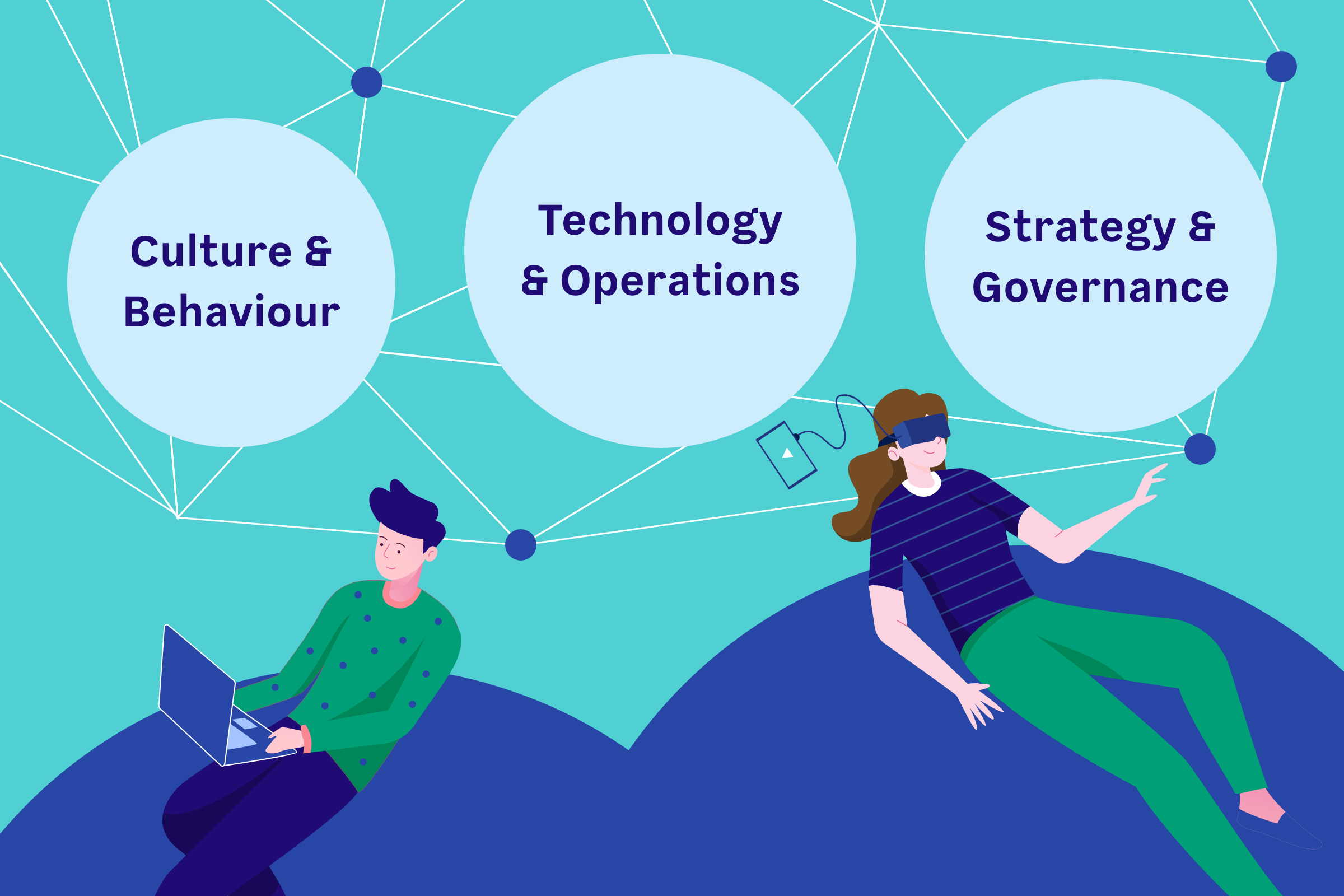The three vital components of a data-enabled organisation
Becoming a data-empowered organization will strengthen and accelerate your innovation power and make your company more resilient. On this journey, strategy, change management, and culture are as important as tech, tools, and data science expertise. In order to get started on your journey towards becoming data-enabled, you need to understand what the defining characteristics of such an organisation are.

1. Strategy & Governance
The one thing that bears repeating: Data should underpin your strategy and help you solve your key business problems.
Implementing a data strategy requires transparency. Your data strategy must align with the desired business outcomes or goals expressed by the owners, board, or executive committee.
So leadership buy-in is crucial for a successful data-enabled business transformation. By tying the data strategy to the business strategy, communicating its value for your organisation becomes a lot easier. Some organisations manifest their commitment to becoming data-enabled by appointing or hiring a CDO (Chief Data Officer), others place the responsibility in the hand of the CIO (Chief Innovation Officer). Whatever approach is right for you, a successful data strategy requires ownership on the C-level, with endorsement and support from the CEO, executive team, or board. A verbal endorsement must be accompanied by adequate funding for data-related initiatives.
Ideally, your data strategy should combine two horizons:
1. Short term: Showing early wins for business value and its impact to demonstrate the first possibilities and educate the rest of the organisation. These are often related to optimizations or increased efficiency.
2. Long term: Focus on the desired end state that is usually only achievable over a longer period of time due to higher complexity and strategic value. Examples are new, innovative functionalities or business models that expand the company ambition level.
Governance and risk management are two additional considerations. When it comes to governance, your ambition should be to create a common framework across your organization suitable to meet business, legal and regulatory needs. Clearly define and review potential risks related to data and its usage. This will form the basis of a risk mitigation plan.
The outcome is a combined roadmap including your data strategy, aligned with your governance framework and risk mitigation activities. The strategic roadmap is the foundation of your transformation.
2. Culture & Behavior
At the heart of any organisation is its culture: Shared behaviours, beliefs, values and assumptions that influence how people behave and act in their jobs. Data culture governs how employees view and act upon data. Like any cultural change, embedding a data culture takes time, commitment and perseverance. Solving technical data problems is hard, changing culture and behaviour is even harder. It’s definitely worth the effort, though.
“Putting data in the hands of a few experts is a powerful thing, but making it available throughout the organisation can be a game-changer.” (Doug Bordanora, Info World, March 2018)
If data as a resource is seen as relevant to only specific parts of an organisation, instead of integrated in a holistic and strategic manner across the entire organization, your transformation ambitions will be undermined. People who are refused access to data can't help but question the insights, information, and decisions that are derived from it.
One can investigate employees' data mindset and data-savviness by asking a simple question: “How do you use data to make decisions?” A data mindset is not only relevant for data scientists or engineers, but also for designers, strategists and especially for internal functions such as HR.
In a multi-disciplinary approach, designers, for example, use a data-informed design process that combines a qualitative human-centred approach with rational insights gathered qualitatively. This path not only guides strategic decisions but also informs tactical decisions and helps discover opportunities for incremental improvements or innovation along the way.
In the end, the right mindset is manifested in the way people work. Start making data available to everyone in the organization and provide the tools to analyse it. Airbnb has built a user-friendly Dataportal that helps every employee navigate the data landscape and find relevant resources. Combine this self-service data culture with collaborative and multidisciplinary problem solving and new ideas emerge.
A healthy data culture fosters data-enabled decision-making across all levels and disciplines. A healthy data culture is one where people ask, "Where is the data to back that up?".
3. Technology & Operations
Technology may not be the biggest barrier to transformation, - possibly because it gets the attention and budgets it deserves - but there are a few important things to consider. We will highlight a few aspects of data and operational technology that have a major impact on how data-enabled an organisation really becomes.
Data Governance is teamwork. It requires a combination of ethics, company values, data quality and security. For example, now that organizational data is being used more, we need to be very clear in communicating to employees exactly how and why this data is used, stored, who has access to it, and, most importantly, how it shouldn’t be used.
Futurice’s values are transparency and care. Thus it is important for us to apply those principles to our data governance. One example is that we have developed the Our Data initiative, a platform where any futuricean can see what data there is of them in the data lake, giving them options to opt out of certain services. You can watch a webinar recording about the initiative from here. We are also putting together a data governance community of employees who oversee data governance to get a broad perspective on how we can live our values.
Data tools are key to becoming data-enabled as they allow employees not only access to data but add a layer of usability on top which should aim to make data exploration easier. It is thus important that data tools are built with the user's needs not only in mind but are an integral part of the development or decision-making process. Creating such tools and applications does not only require top tech talent but also experienced designers advocating and implementing user needs into a seamless experience. Setting up a proper data infrastructure, data lakes, cleaning data etc. takes time. Therefore, it is important to prioritise solving key business problems and build from there rather than trying to solve everything at once.
Systemic change is needed to become data-enabled
The data and AI paradigm shift will force us to rethink organizational structures, processes and workflows, metrics, governance and decision-making, and, of course, culture. It’s about a lot more than just an increase in efficiency – it’s a systemic change. A change that leads to becoming an innovative and resilient organisation.
At Futurice we embarked on our own journey to becoming a data-enabled and eventually an AI-powered organisation. We are learning every day and developing tools for our employees and clients that add value. Our head of Data & IT developed a data governance process and we are upgrading our data infrastructure in order to support our business development.
Where are you along this transformation journey?
To read part one of this two-part series, click here.
For more information about our data-related thinking and doing, check out:
Article: The Connected Company arises with Data & AI
Recordings of our webinars on connected companies (May/June 2020)
 Melanie DreserPrincipal Designer
Melanie DreserPrincipal Designer Fransje SchoenmakerData Culture & Strategy Lead
Fransje SchoenmakerData Culture & Strategy Lead


